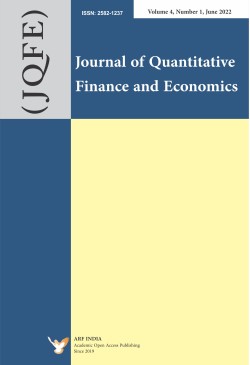
Journal of Quantitative Finance and Economics
Frequency :Bi-Annual
ISSN :2582-1237
Peer Reviewed Journal
Nexus between growth and unemployment is inverse but empirically this relationship is not true in all economies in all the time.The author attempted to relate US unemployment with growth during 1948-2016 using bivariate and log regression models,Bai-Perron Model, Granger Causality test, Johansen co integration test,vector auto regression and vector error correction models.Even, author finds out the relation between unemployment gap, output gap and growth in USA during 1948-2016. US unemployment rate, GDP and growth rate have been taken from Bureau of US census during 1948-2016.US natural rate of unemployment was taken from Fed Bank of St.Louis during 1949-2016.The paper concludes that US unemployment rate has been increasing at the rate of 0.507 per cent per year and it has one upward structural break in 1971. It follows Okun’s law.US unemployment and growth rate are negatively related during 1948-2016 which is significant at 5% level. There is no causality and no co integration between them.VAR model is stable and stationary. Residual test showed non-normality, heteroscedasticity and auto correlations. Moreover, author showed negative relation between growth and unemployment gap in USA during 1949-2016.They have no causality and co integration. Their VAR model is stable and stationary. The residual test proved heteroscedasti city,non-normality and auto-correlation problems.In USA, output gap influenced unemployment gap negatively during 1949-2016 significantly.It has significant bi-directional causality and one co integrating equation. In Vector error correction model, error corrections are significant with high speed having stability, auto correlation and non-normality.Therefore, jobless growth was not observed in USA during 1948-2016.
Key words: Output Gap,Unemployment Gap,Cointegration,Vector Error Correction.
Extending Ram (1986, 1989), Smyth and Hsing (1995), and Goel, Payne and Ram (2008), this study finds that a higher government debt-to-GDP ratio raises the growth rate of real GDP if the debt ratio is up to 39.3221% and reduces the growth rate of real GDP if the debt ratio is greater than 39.3221%. In addition, a higher growth rate of employment, a higher investment-to-GDP ratio, and a higher growth rate of real M2 raise the growth rate of real GDP. Therefore, the Reinhart-Rogoff debt threshold of 90%does not apply to Indonesia.
Keywords: Government debtratio, Reinhart-Rogoff hypothesis, fiscal policy, debt threshold
JEL Classification: E62
Based on an extended Mundell-Fleming model, this article finds that fiscal expansion reduces output and leads to real appreciation of the rupee whereas monetary expansion raises output and results in real depreciation of the rupee. Hence, except for the effect of fiscal expansion on output, the predictions of the Mundell-Fleming model are applicable to Sri Lanka.
Keywords: fiscal policy, monetary policy, exchange rates,Mundell-Fleming model
JEL Classification: F41, E52, E62
The study examined the dynamic effect of pollutant emissions and institutions on economic growth in Nigeria. Secondary data for the periods of 1980-2015 were sourced from World Bank Development Indicators and Central Bank of Nigeria statistical bulletins (several issues).VECM based impulse response, variance decomposition and other cointegrating regression techniques such as Fully Modified OLS and Dynamic OLS including Generalised Method of Moment were employed to analyze the data and estimate the model built for the study. The results showed that democratic accountability has positive impact on economic growth while CO2 emissions have negative and significant impact on economic growth in Nigeria. The results also confirmed that bureaucratic quality improve the level of economic growth. Governance stability had significant effect on economic growth. This result showed that institutions cannot be overlooked in the growth process as far as Nigeria is concerned. Furthermore,the response of economic growth to a one standard deviation innovation in its past values was significantly positive in the short run with negative values in the medium and long runs. Similarly, the impulse response function showed that a shock to CO2 emission would produce no immediate effect on economic growth but its effect in the medium run was negative before responding positively in the long run. In the same way, the impulse response function showed that a shock to democratic accountability produced no immediate effect on economic growth but its effect in the medium run was negative with significant negative response in the long run. The study concluded that strong institution is needed to reduce the negative effect of CO2 emission on economic growth in Nigeria.
Keywords: VECM, institutions, Nigeria, growth, pollutions
We show that expected returns in the Black capital asset pricing model are driven only by the market portfolio and the global minimum-variance portfolio (GMVP). Expected return of a portfolio is a linear combination of expected market and GMVP returns less a cost which is the present value of cash flows under the well-known Gordon Growth Model, where the growth rate is the expected return of the GMVP, and the discount rate is the expected market return.
Keywords: Black CAPM, expected return, global minimum-variance portfolio, zero–beta asset
JEL Classification: G10, G11, G12